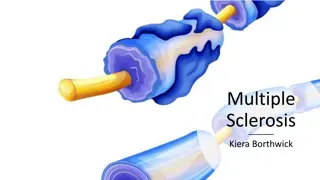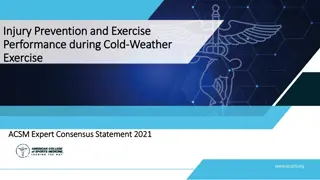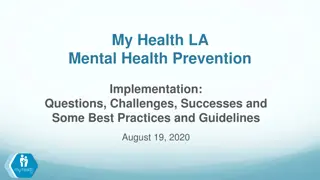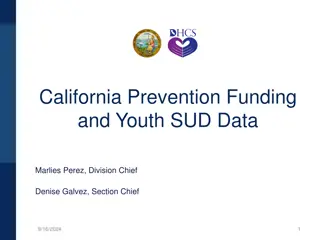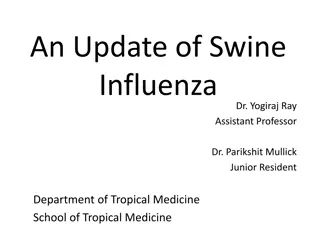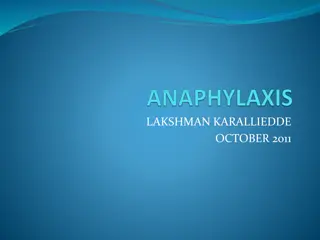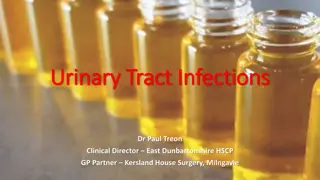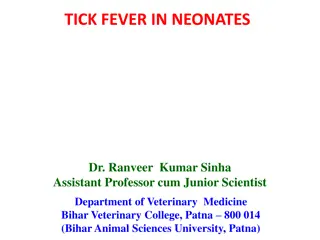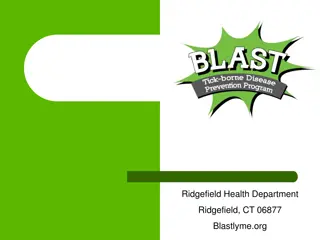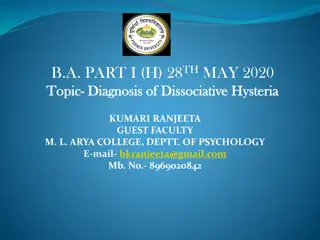Understanding Ringworm: Symptoms, Treatment, and Prevention
Ringworm, a common fungal infection, manifests as small, reddish, itchy patches that form ring-shaped lesions on the skin. It is contagious and can recur over many years if left untreated. Effective treatment involves anti-fungal topical creams or oral prescriptions in severe cases. Exclusion from school and daycare is necessary until treatment begins. Close contacts should be monitored for symptoms, and infected individuals should avoid activities that may expose others. Prompt medical attention is crucial for diagnosis and management. Prevention practices can help reduce the spread of ringworm infections.
Download Presentation

Please find below an Image/Link to download the presentation.
The content on the website is provided AS IS for your information and personal use only. It may not be sold, licensed, or shared on other websites without obtaining consent from the author. Download presentation by click this link. If you encounter any issues during the download, it is possible that the publisher has removed the file from their server.
E N D
Presentation Transcript
Ringworm Cape Girardeau County Public Health Center Presented by Sand Gibbons R.N.
Ringwrom Also known as Tinea corporis-which refers to a fungal infection that appears on the scalp, between the toes, in the groin, in a man s beard and other places on the body.
Symptoms Small, reddish, itchy, scaly patches that gradually expand outward clearing in the middle, forming a flat, spreading ring-shaped lesion with scaling margins and clear centers. New legions may form in the middle of an expanding ring. Usually appear as a single lesion.
Incubation period 4-10 days. The condition may persist and recur for many years
Period of Communicability Contagious as long as active lesions are present.
School and Daycare Attendance Exclude until effective treatment is started. Usually treated with anti-fungal topical creams or ointments. In severe cases may require oral prescription.
Contacts/Follow-up Watch for development of infection in other children and caregivers who provide direct, physical care to young children. Parents should be notified that there has been a case or cases of ringworm, and advised to watch for the development of symptoms. If found, they should seek medical attention for diagnosis and treatment. Infected children should be excluded form swimming or other activities likely to lead to the exposure of others.
Ringworm Also known as Tinea Capitis-(can also be known as craddle cap)refers to a fungal infection particularly of the scalp, but can also appear in a man s beard, in the ground and between toes.
Symptoms Round, scaly, localized patches on the scalp with short, broken-off hairs. Redness and scaliness may be present and range from mild to severe.
Incubation Period 10-14 days. The condition may spread for 3-4 months, and then spontaneous regression may occur
Period of Communicability As long as active lesions are present or viable fungus persists on contaminated areas(may persist for a long time)
School Attendance Exclude until effective treatment is started. Usually requires prescription oral medication and anti-fungal shampoos or other topical treatment.
Contacts/Follow-up Watch for development of infection in other children and caregivers who provide direct, physical care to young children. Have family check pets and farm animals for infection and treat if infected.
Facts Ringworm is not actually caused by a worm, but by fungi It is a contagious fungal infection caused by mold- like parasites, known as dermatophytes, that live on the outer skin. Ringworm occurs more commonly in warm, tropical environments. It affects men and women of all ages fairly equally, although it is more common amongst children.
Transmission Highly contagious Transmitted from direct skin-to skin contact with infected people or pets. By sharing hats and personal hair grooming items (eg. hairbrushes, combs) Contact with locker rooms floors, shower stalls, seats Clothing from an infected person
Transmission continued It can also be spread by touching surfaces contaminated with the fungus, such as door knobs, towels, bedding and soil.
Other Causes Having damp skin for an extended period of time (eg. sweat) Lack of hygiene Minor skin and nail injuries Close contact with others(eg. Sports like wrestling)
Risk Factors Contact with surfaces( eg. Seat backs, shower stalls), clothing, or personal grooming items used by an infected person Skin-to-skin contact with an infected person or pet Age 12 or younger-ringworm of the scalp rarely occurs in children after puberty or in adults Spending time in nurseries, schools, daycare center, or locker room
Diagnosis Many cases are self diagnosable, but some can mimic other skin conditions. A primary care physician or dermatologist will likely be able to identify a ringworm, solely by its appearance. A KOH test will provide an accurate diagnosis Fungal cultures are rarely taken to identify the exact fungus causing the infection.
Treatments Topical anti-fungal cream are applied to lesions twice a day for at least 3 weeks. The lesions usually clear up within two weeks, but treatment should be continued for another week to insure the fungus is completely gone. Topical creams can be purchased over-the- counter, or a Dr. may prescribe.
Treatments continued When using a topical cream, wash and dry the affected area(s) before applying the cream to the rash. Be sure to wash hands thoroughly after applying the cream to the rash. Do not apply bandage over the rash
Most commonly Topical Creams Monistic (miconazole) Mycelex (clotrimazole) Nizoral (ketoconazole) Lamisil (terbinafine)
Oral treatment Rarely used (used if severe infection or several lesions) Taken once a day for 7 days and have a 100 percent clinical cure. Oral anti-fungals medications: Terbinafine (Lamisil) 250 mg Itraconazole (Sporanox) 200 mg
Prevention Keep skin dry and clean Avoid contact with infected materials Maintain proper hygiene habits, especially if participating in sports that require close physical contact with others Wash hands after handling animals, soils and plants Do not touch characteristic lesions on other people
Prevention continued Wear loose-fitting clothing Keep damp areas where fungi thrive clean, (eg. Bathtubs, bathroom floors, sinks etc).
True or False Ringworm in general is highly contagious True As long as lesions are present
True or False Ringworm is cause by ingesting food contaminated with the worms? False- It is not actually caused by a worm, but fungi
True or False Ringworm generally affects older men more than women? False- It affects women and men equally, although it is more common amongst children under the age of 12
Name 3 ways ringworm can be transmitted Skin-to-skin with infected people or pets Sharing hats and personal hair grooming items Contact with locker rooms, shower stalls, and seats Clothing from an infected person Touching surfaces contaminated with the fungus, such as doorknobs, towels, bedding and soil
Name 3 things that may increase your chance of contacting ringworm ? Having damp skin for an extended period of time Lack of hygiene Minor skin and nail injuries Close contact with others (eg. Sports like wrestling) Spending time in nurseries, schools daycare centers, or locker room
True or False A doctor must diagnose and prescribe treatment for all types of ringworms? False Many cases or self diagnosable, by its appearance. Most ringworm of the skin can be treated with over the counter topical creams Rarely, oral medicine is used unless severe infection or several lesions. Also, sometime with ringworm on the scalp, a prescription oral medicine or shampoo is needed.
Name 3 preventions to take against ringworm? Keep skin dry and clean Avoid contact with infected material Maintain proper hygiene habits, especially if participating in sports that require physical contact with others
Name 2 types or ringworm Tinea Corporis- fungal infection that appears on the scalp, between the toes, in the groin, in a man s beard and other places on the body Tinea Capitis -a fungal infection particularly of the scalp.
True or False The child can return to school as long as he has the area covered with a bandage? False You should never cover a ringworm with a bandage, and the child should not return until after proper treatment as been started
True or False You apply cream until you can no longer see the area, then you may stop treatment? False The area may disappear after two weeks of applying the cream, but you must continue for three full weeks.
Remember Have a policy and a parent letter to send home ready at your daycare, before you need it Thank you





